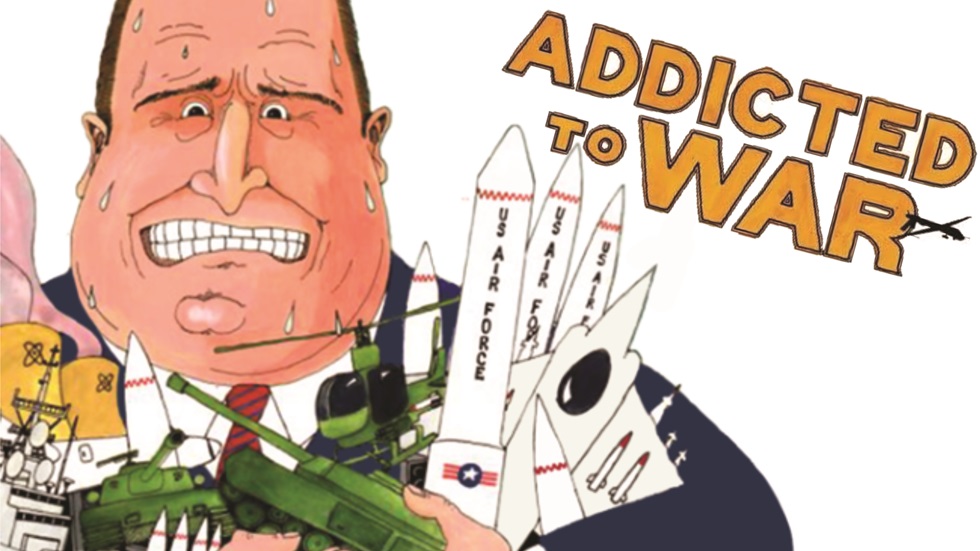
$2.5 trillion dollars. That’s the amount the United States currently spends on war, per a recent mailer I received from the War Resisters League. This number, is an increase of over $200 billion since last year, despite the end of the long-running war in Afghanistan and the replacement of the bellicose Donald Trump with supposedly more pacific Joe Biden. Given this gargantuan military budget, which dwarfs the military budgets of Russia and China combined, it’s worth asking: Is the United States a nation of war addicts?
Joel Andreas’s comic Addicted to War: Why the U.S. Can’t Kick Militarism has been making the affirmative case since 1991. Andreas had created two prior illustrated exposés: The Incredible Rocky, about the activities of Nelson Rockefeller, and Made With Pure Rocky Mountain Scab Labor, about the boycott against Coors. Neither of those issues or books has had the longevity of Addicted to War, which has been printed in over a dozen countries and sold over 450,000 copies. The book has been endorsed by Veterans for Peace, along with figures such as Noam Chomsky and the recently deceased Reverend J.M. Lawson. In a 2014 speech, David Swanson of Veterans for Peace called the book “a powerful tool for war abolition right up until war is abolished.” Radical publisher PM Press has reprinted Addicted to War this year.
Andreas comes from a pacifist background; his father was a Mennonite and his mother was a longtime anti-war activist, a calling he followed. When the Persian Gulf War began, he took up his drawing implements to make a case against that war, originally for an 8-16 page comic. He found that in order to explain the purposes, stated and unstated, for that war, he had to go even further back in history “because people don’t really recognize the U.S. as a militarist power.” The origins of American militarism would take more than 16 pages to tell.
Addicted to War begins with the sadly common scenario of schools needing to fundraise on their own for much needed supplies. When irate students, parents, and staff go to the school board, they are told that the federal government doesn’t provide enough aid to schools. Around the country we can see examples of this official neglect. In Baltimore schools lacked heating in the winter, while New York schools can only afford 260 librarians for 1,600 schools Instead of spending more money to fix these problems, over half of federal discretionary spending is spending on the military. From here, Andreas moves on to a critique of U.S. history, influenced by Howard Zinn’s A People’s History of the United States, showing how this high level of military spending came to pass. His points are substantiated with over 150 footnotes at the rear of the book.
There’s a lot of discussion in the United States as to when the country lost its innocence. Was it 9/11? Watergate? Jack Kennedy’s assassination? None of these hold water with Andreas. He documents that there was always an aggressive, expansionist underside to the American project. He quotes a Representative William F. Giles as declaring, “We must march from ocean to ocean…It is the destiny of the white race.” Teddy Roosevelt states in these pages, “I should welcome almost any war, for I think this country needs one.” Senator Orville Platt proclaims that the nation “ought to lose no time in acquiring” overseas territory. Clearly there were warning signs well before the U.S. was spending trillions on military expenditure.
Contrary to conventional wisdom, this imperial period was not confined to the turn of the last century. Andreas convincingly shows how economic interests drove numerous foreign interventions. President Wilson’s ambassador to England revealed that the United States declared war on Germany during World War I as a way of “maintaining our present pre-eminent trade status.” Seemingly no piece of anti-war writing is complete without quoting from decorated Marine Corps General Smedley Butler, author of the famous pamphlet “War is a Racket.” In Addicted to War a comic version mourns the loss of American lives in imperial adventures in Europe and Latin America. “Our boys were sent off to die with beautiful ideals painted in front of them,” he observes. “No one told them that dollars and cents were the real reason they were marching off to kill and die.”
More recently, per Andreas, the eight-year war in Iraq was substantially fought for control over that country’s oil reserves. One general outright says that “Of course it’s about oil. We can’t really deny that.” And then there are the war contractors, the GEs, the Raytheons, the Boeings, etc. all of whom make billions from military contracts. They then spend vast sums lobbying Congress to increase defense spending, which really means an increase to their profits. Edwin Starr sang that war was good for “absolutely nothing.” Tell that to General Dynamics.
All this text, though, threatens to overwhelm Andreas’s rather sparse artwork. Fortunately, he has found eye-catching images from other mediums to support his points. He includes political cartoons from American history to aid him in making his points. These cartoons put the lie to the common argument, usually made by conservatives, that “everyone thought that way” about certain historic crimes. With the cartoons, Andreas finds photographs from some of the major conflicts addressed in the book. Andreas’s cartooning can be funny, yet the photos he chooses are deadly serious. They heighten the emotional impact of Addicted to War. It’s one thing to read about U.S. imperialism in Nicaragua; it’s quite another to actually see a U.S. Marine hoist up the severed head of one of Sandino’s rebels.
While Andreas’s argument is cogent, the book is overall weakened by a lack of timeliness. Although this reprint was released this year, this is the same edition of Addicted to War that came out in 2015. The current President is shown to be Barack Obama, the drone wars are a recent conflict, and most unfortunately, Chelsea Manning is referred to by her deadname. The last of these could have easily been fixed with changes to one text box; that it was not is regrettable.
Reading Addicted to War raises the same question an old Russian revolutionary formulated over a century ago: What is to be done? Andreas provides some answers for how to break the U.S.’s war habit. He includes a list of peace organizations, along with their contact information, to close out Addicted to War. These range from the religious (American Friends Service Committee, Fellowship of Reconciliation) to the secular (Peace Action, War Resisters League) and readers are encouraged to join one that comports with their beliefs. He also cites the examples of the anti-Vietnam War movement to show how sustained mass pressure can end a war of aggression.
PM Press’s latest printing of Addicted to War addresses the sadly timeless issues of militarism and the military industrial complex, but the book itself is behind the times. While the historical aspects are all still valid, today’s anti-war activists need a critique of contemporary militarism, not just the militarism of the past. Nonetheless, as an educational tool, the book does a fine job of explaining the history of the nation’s enthrallment to war.
We hope you appreciated this article. At People’s World, we believe news and information should be free and accessible to all, but we need your help. Our journalism is free of corporate influence and paywalls because we are totally reader-supported. Only you, our readers and supporters, make this possible. If you enjoy reading People’s World and the stories we bring you, please support our work by donating or becoming a monthly sustainer today. Thank you!










